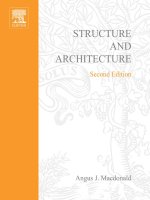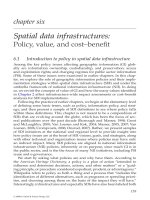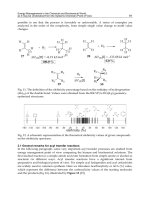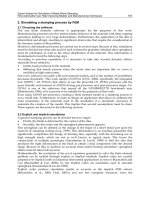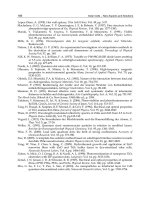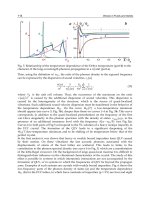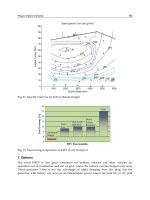Structure and Architecture - Chapter 6 pot
Bạn đang xem bản rút gọn của tài liệu. Xem và tải ngay bản đầy đủ của tài liệu tại đây (163.58 KB, 13 trang )
6.1 Introduction
It is said, albeit usually by critics, that creative
activity is enriched by criticism. The world of
structural engineering, in which a very large
number of artefacts are created continuously,
is, however, curiously devoid of a climate of
criticism, and few engineering structures
receive anything like the critical attention
which is accorded to even the most modest of
buildings. There is therefore no tradition of
criticism in structural engineering comparable
to that which exists in architecture and the
other arts
1
.
Design has been described as a problem-
solving activity, an iterative process in which
self-criticism by the designer forms an
essential part. It is with this type of criticism,
rather than the journalistic type alluded to
above, that this chapter is principally
concerned. It is not proposed, therefore, to
deal comprehensively here with the subject of
structural criticism but simply to identify the
technical factors by which the merits of
structures may be assessed.
Engineering is principally concerned with
economy of means – a structure may be
considered to have been well engineered if it
fulfils its function with a minimum input of
materials and other resources. This does not
mean that the most efficient
2
structure, which
produces the required load-carrying capacity
with a minimum weight of material, is
necessarily the best; several other technical
factors, including the complexity of the
construction process and the subsequent
durability of the structure, will affect the
judgement of whether or not a structure is
satisfactory. Frequently, the technical
requirements conflict with one another. For
example, as was seen in Chapter 4, efficient
forms are invariably complex and therefore
difficult to design, construct and maintain.
This dichotomy between efficiency and
simplicity of form is a fundamental aspect of
structural design. The final geometry which is
adopted is always a compromise between
these two properties, and the elegance with
which this compromise is achieved is one of
the principal criteria of good structural design.
In the context of architecture it affects the
relationship between the appearance and the
performance of a structure. The factors on
which the nature of the best compromise
depends are reviewed here.
6.2 Complexity and efficiency in
structural design
A fundamental engineering requirement is that
economy of means should be achieved. The
60
Chapter 6
The critical appraisal of
structures
1 The controversy over whether or not structural
engineering is an art will not be entered into here. This
is discussed at length in Billington, D. P., The Tower and
the Bridge, MIT Press, Cambridge, MA, 1983 and Holgate,
A., The Art in Structural Design, Clarendon Press, Oxford,
1986. See also Addis, W. B., The Art of the Structural
Engineer, Artemis, London, 1994.
2 As in Chapter 4, structural efficiency is considered here
in terms of the weight of material which has to be
provided to carry a given amount of load. The efficiency
of a structure is regarded as high if the ratio of its
strength to its weight is high.
overall level of resources committed to a
project should be as small as possible. A
sensible balance should be struck between the
complexity required for high structural
efficiency (see Chapter 4) and the ease of
design, construction and maintenance which
the adoption of a simple arrangement allows.
It is the nature of this compromise which must
be assessed by the critic who wishes to judge
the merits of a structure.
The aspects of structure on which efficiency
depends, where efficiency is judged primarily
in terms of the weight of material which must
be provided to give a particular load-carrying
capacity, were outlined in Chapter 4. It was
shown that the volume and therefore the
weight of material required for a structure is
dependent principally on its overall form in
relation to the pattern of applied load and on
the shapes of the structural elements in both
cross-section and longitudinal profile. A basic
classification system based on the concepts of
form-active shape and ‘simple’ and ‘improved’
cross-sections and longitudinal profiles was
described; this allows judgements to be made
concerning the level of efficiency which is likely
to be achieved with a particular structural
arrangement. Form-active shapes such as
tensile cables and compressive vaults were
seen to be potentially the most efficient, and
non-form-active beams the least efficient.
A property of structures which was
demonstrated by this ordering of elements is
that the higher the efficiency the more complex
the form
3
. This is generally the case even when
relatively minor measures are taken to improve
structural efficiency, such as the use of I-
shaped or box-shaped cross-sections for
beams instead of solid rectangles, or a
triangulated internal geometry instead of a
solid web for a girder.
The complicated geometry which must be
adopted to obtain high efficiency affects the
ease with which a structure can be constructed
and its constituent components manufactured,
and its subsequent durability. For example, a
triangulated framework is both more difficult
to construct and more difficult to maintain
subsequently than is a solid-web beam. The
designer of a structure must therefore balance
these considerations against the natural desire
to minimise the amount of material involved.
The level of efficiency which has been achieved
should be appropriate for the individual
circumstances of the structure.
It is not possible to specify precisely the
level of efficiency which should be achieved in
a particular structure, such is the complexity
of the interrelationships between the various
factors involved. It is possible, however, to
identify two main influences on this desirable
level, namely the size of the span which a
structure must achieve and the intensity of
the external load which it will carry. The
longer the span, the greater is the need for
high efficiency; the higher the level of load
which is carried, the lower can the efficiency
be. These two influences are in fact different
aspects of the same phenomenon, namely a
requirement to maintain the ratio of self-
weight to external load at a more or less
constant level. Implicit in this statement is
the idea that, in order to achieve the ideal of
maximum economy of means, the level of
complexity of a structure should be the
minimum consistent with achieving a
reasonable level of efficiency.
The effect on efficiency of increasing span is
demonstrated in the very simple example of a
beam of rectangular cross-section carrying a
uniformly distributed load (Fig. 6.1). In the
figure, two beams of different spans are shown,
each carrying the same intensity of load. The
one with the longer span must have a greater
depth so as to have adequate strength. The
self-weight of each beam is directly
proportional to its depth and so the ratio of
load carried to self-weight per unit length of
beam (the structural efficiency) is less
favourable for the larger span.
61
The critical appraisal of structures
3 The concept of the optimum structure provides further
evidence that complexity is necessary to achieve high
levels of efficiency – see Cox, H. L., The Design of
Structures of Least Weight, Pergamon, London, 1965 and
Majid, K. I., Optimum Design of Structures, Newnes-
Butterworth, London, 1974.
Another way of demonstrating the same
effect would be to use a beam element with a
particular cross-section across a range of
spans. The strength of the beam – its moment
of resistance (see Appendix 2.3) – would be
constant. At small spans the maximum
bending moment generated by the self-weight
would be low and the beam might have a
reasonable capacity to carry additional load.
As the span was increased the bending
moment generated by the self-weight would
increase and an ever greater proportion of the
strength available would have to be devoted to
carrying the self-weight. Eventually a span
would be reached in which all of the strength
available was required to support only the self-
weight. The structural efficiency of the beam
(its capacity to carry external load divided by
its weight) would steadily diminish as the span
increased.
Thus, in the case of a horizontal span, which
is the most common type of structure found in
architecture, the efficiency of an element with
a particular shape of cross-section decreases
as the span increases. To maintain a constant
level of efficiency over a range of spans,
different shapes of cross-section have to be
used. More efficient shapes have to be used as
the span is increased if a constant level of load
to self-weight (efficiency) is to be maintained.
The general principle involved here is that
the larger the span, the greater the number of
‘improvements’ required to maintain a
constant level of efficiency. The principle may
be extended to the overall form of a structure
and indeed to the full range of factors which
affect efficiency. Thus, to maintain a constant
level of efficiency over a wide range of span,
simple non-form-active structures might be
appropriate for short spans. As the span is
increased, elements with progressively more of
the features associated with efficiency are
required to maintain a constant level of
efficiency. At intermediate spans semi-form-
active types are required, again progressing
through the range of possibilities for
‘improvement’. For the very largest spans,
form-active structures have to be specified.
The relationship between structural
efficiency and intensity of applied load, which
is the other significant factor affecting
‘economy of means’, can also be fairly easily
demonstrated. Taking again the simple
example of a beam with a rectangular cross-
section, the weight of this increases in direct
proportion with its depth while its strength
increases with the square of its depth (see
Appendix 2.3). Thus, if the external load is
increased by a factor of two the doubling in
strength which is required to carry this can be
achieved by an increase in the depth which is
less than twofold (in fact, by a factor of 1.4).
The increase in the weight of the beam is
therefore also less than twofold and the overall
efficiency of the element carrying the double
load is greater. Thus, for a given span and
shape of cross-section, the efficiency of the
element increases as the intensity of load
increases and larger cross-sections must be
specified. Conversely, if a particular level of
efficiency is required, this can be achieved with
less efficient shapes of cross-section when
heavier loads are carried (the relationship
between efficiency and shape of cross-section
is discussed in Section 4.3 and in Appendix
2.3).
Structure and Architecture
62
Fig. 6.1 The weight of a beam is
proportional to its depth, which must
increase as span increases. Thus, the ratio
of self-weight to imposed load carried
becomes less favourable as span is
increased.
An examination of extant structures
demonstrates that the majority are in fact
designed in accordance with an awareness of
the relationship between span, load and
efficiency described above. Although it is
always possible to find exceptions, it is
nevertheless generally true that structures of
short span are mainly produced in
configurations which are inefficient, i.e. post-
and-beam non-form-active arrangements with
‘simple’ shapes in cross-section and
longitudinal profile. As spans increase the
incidence of features which produce increased
efficiency is greater and structures with very
long spans are always constructed in efficient
formats. This is very obvious in bridge
engineering, as is illustrated in Fig. 6.2, and
can be demonstrated to be broadly true of
building structures.
The most obvious demonstration of the
influence of load intensity on the type of
element which is employed is found in multi-
storey frameworks. The principal loads on the
horizontal structural elements of these are
gravitational loads and, of these, floor loads
are of much higher intensity than roof loads
(from two to ten times as much). In multi-
storey frameworks it is very common for
different structural configurations to be used
for floor and roof structures, with roof
structures being given more of the features
which are associated with greater structural
efficiency, even though the spans are the same
(see Fig. 5.13).
From all of the foregoing it is possible to
picture a fairly tidy taxonomy of structures in
which the type of structure which would be
most suitable for a particular application
would range from the simplest post-and-beam
non-form-active types for very short spans,
through a series of ‘improved’ non-form-active
or semi-form-active types in the medium span
range, to form-active structures for the longest
spans. Because the underlying requirement of
structural design is to produce a ratio of load
to self-weight which is approximately constant,
the precise levels of span at which transitions
from less to more efficient types of element
would be appropriate would be affected by the
load intensity: the higher the load carried, the
longer would be the span at which the change
to a more efficient type would be justified. The
technical factor which determines the precise
level of span for which a particular structural
configuration is most appropriate is the
fundamental engineering requirement that
economy of means should be achieved.
One indicator of the extent to which the
correct balance between complexity (and
therefore efficiency) and simplicity has been
achieved is cost. Although monetary cost is
not strictly a technical aspect of the
performance of a structure it does give an
indication of the level of resources of all kinds
which will have been involved in its realisation.
Cost is therefore a measure of the level of
economy of means which has been achieved
and is frequently crucial in determining the
63
The critical appraisal of structures
Fig. 6.2 The four bridges illustrated here demonstrate
the tendency for structural complexity to increase with
span due to the need for greater efficiency. (a) Luzancy
Bridge; span 55 m, post-and-beam. (b) Salginatobel
Bridge; span 90 m, compressive-form-active arch with solid
cross-section. (c) Bayonne Bridge, span 504 m,
compressive form-active arch with ‘improved’ triangulated
longitudinal profile. (d) Severn Bridge, span 990 m, tensile
form-active.
(a)
(b)
(c)
(d)
balance of efficiency and complexity which is
appropriate in a particular case.
Cost is, of course, an artificial yardstick
which is affected by the ways in which a society
chooses to order its priorities. These are likely,
increasingly, to be related to the realities of
shortages of materials and energy, and to the
need to reduce levels of industrial pollution.
Cost, which, in the economic context of the
modern world of the twentieth century, was
largely unrelated to these aspects of reality
and which was eschewed by critics of
architecture as a measure of the worth of a
building, may, in the twenty-first century
become an important consideration in the
assessment of the appropriateness of a
structure.
As with other aspects of design the issues
which affect cost are related in complicated
ways. For example, in considering cost in
relation to structural design, the designer must
take into account not only the cost of the
structure itself but also the effect of the
selection of a particular structure type on other
building costs. If, for example, it proved
possible to reduce the cost of a multi-storey
structure by slightly increasing the structural
depth of each floor, this saving might be
counteracted by an increase in the cost of the
cladding and other building components. If a
structure type were selected which, although
more expensive than an alternative, allowed
the building to be erected more quickly (e.g. a
steel rather than a reinforced concrete frame),
the increase in the cost of the structure might
be more than offset by the savings involved in
having the building completed more quickly.
The issue of cost, in relation to structural
design, must therefore involve a consideration
of other issues besides those which are solely
concerned with the structure. Such factors are
especially important when the cost of the
structure itself may form a relatively small
proportion of the total cost of the building. In
spite of these reservations, it is nevertheless
possible to make certain general observations
concerning the issue of purely structural costs.
Cost, and in particular the relationship
between labour costs and material costs in the
economy within which the structure is
constructed, strongly influences the ratio of
load carried to self-weight which is appropriate
within a particular economic regime. This is a
major factor in determining the spans at which
the transition from less to more structurally
efficient forms are made.
This can be illustrated by considering the
relationship between material and labour costs
for a particular structure. Consider, for
example, the problem of a single-storey
building of moderate span – an example might
be the Renault Centre (Fig. 3.19). It may be
assumed that a steel framework is a sensible
form of structure to support such an enclosure
but the range of structural possibilities
available to the designer is very large. Simple
post-and-beam forms with parallel-sided
beams would be the least structurally efficient
option. Semi-form-active portal frameworks
with triangulated elements would be more
efficient. A cable supported structure or tent
would give the greatest efficiency in the use of
material. The higher the efficiency, the greater
the complexity and therefore the higher would
be the design and construction costs.
The relationship between material and
labour costs of all kinds is represented
diagramatically in Fig. 6.3. The optimum level
of efficiency corresponds with the minimum
point in the curve indicating the total costs;
this will correspond to a particular type of
structure. Figure 6.3 also illustrates the effect
of a variation in labour cost. The effect of an
increase in labour costs, relative to material
costs, is to reduce the level of efficiency at
which the optimum level of economy of means
occurs. This effect accounts for variations in
patterns of building in different parts of the
world. The higher the cost of materials in
relation to labour, the greater is the incentive
to achieve high efficiency and the smaller is
the span at which the transition from less to
more efficient and therefore more complex
configurations is justified.
Extreme examples of this are found in tribal
societies in which the economic conditions are
such that very complex structural forms are
used for structures of relatively short span. The
Structure and Architecture
64
Bedouin tent, the igloo (Fig. 1.2) and the yurt
(Fig. 6.4), all of which are form-active
structures, may represent the very many
examples which might be cited. The availability
of ample reserves of labour to build and
maintain complex structures and the fact that
they are the most effective ways of using
locally available materials are responsible for
this use of a wide range of different forms for
short spans, all of them very efficient.
The situation in the industrialised societies
of the developed world is that labour is
expensive in relation to material. This favours
the use of forms which are structurally
inefficient but which are straightforward to
build. The majority of the structures found in
the developed world are inefficient post-and-
beam types, an excellent example of the
profligacy with material of the industrialised
culture.
It is possible to suggest that for a particular
span and load requirement and within a
particular set of economic circumstances there
will be a limited number of appropriate structure
65
The critical appraisal of structures
Cost
Structural
efficiency
Efficiency level for
lowest cost structure
Efficiency level for lowest cost
structure when design and
construction costs are higher
Higher design
and construction
costs
Design and
construction
costs
Total
cost
Total cost when
design and construction
cost is higher
Material costs
Fig. 6.3 The relationship
between structural efficiency
and structural costs for a
structure with a particular span
and load condition are shown
here diagramatically. The
quantity and therefore cost of
material decreases as more
efficient types of structure are
used. The latter have more
complex forms, however, so
the cost of construction and
design increases with
increased structural efficiency.
The curve showing total cost
has a minimum point which
gives the level of efficiency
which is most cost-effective for
that particular structure. If
labour costs increase in
relation to material costs, the
location of the minimum in the
total cost curve is displaced to
the left indicating that a
structural form of lower
efficiency will now be the most
cost-effective.
Fig. 6.4 The yurt is the traditional house of the nomadic
peoples of Asia. It consists of a highly sophisticated
arrangement of self-bracing semi-form-active timber
structural elements which support a non-structural felt
skin. It is light and its domed shape, which combines
maximum internal volume with minimum surface area, is
ideal for heat conservation and also minimises wind
resistance. When judged by purely technical criteria this
building-type will stand comparison with many of those
produced by the so-called technological societies of the
late twentieth century.
types. These will range from the simplest post-
and-beam non-form-active types for the shortest
spans, to form-active shells and cable structures
for the largest spans. The majority of buildings
conform to this pattern but there are exceptions.
Some of these could be regarded as simply ill-
considered designs. Others can be justified by
special circumstances.
For example, if there is a significant
requirement for a lightweight structure, this
would justify the use of a more efficient
structural form than might otherwise be
considered appropriate for the span. Perhaps
the most extreme example of this is the
backpacker’s tent, an extremely short-span
building for which a tensile form-active
structure (the most sophisticated and most
efficient type of structure) is used. The
requirement for minimum weight is, of course,
the justification in this case. Other examples
are buildings which are temporary or which
must be transported, such as those which are
designed to house travelling exhibitions (see
Fig. 7.24) or travelling theatres.
Another reason for adopting a structure type
which might otherwise be considered
inappropriate for the span or load involved
might be that the building had to be built
quickly. Where speed of erection is given the
highest priority, a lightweight steel framework
might be a sensible choice even though other
considerations such as the shortness of the
span might not justify this. The use of
lightweight steel framing for short-span
buildings such as houses, of which the
Hopkins House (Fig. 6.5) is a special case, is an
example of this.
Sometimes, where the structure is part of
the aesthetic programme of the building, a
structure type is selected for its visual features
rather than from a consideration of purely
technical issues. Many of the structures which
are found in so-called ‘high-tech’ architecture
fall into this category. It is always possible to
find examples of buildings in which a client
was prepared to pay excessively and therefore
commit excessive resources in terms of either
materials or labour, in order to have a
spectacular structure which would be
unjustified on purely technical grounds.
A technical issue which has not so far been
considered, but which should form part of any
Structure and Architecture
Fig. 6.5 Hopkins House,
London, UK, 1977;
Michael Hopkins,
architect; Anthony Hunt
Associates, structural
engineers. The very short
spans involved here would
not normally justify the
use of complex
triangulated elements for
the horizontal structure.
Ease and speed of
erection were the main
technical reasons for their
selection. The visual
excitement which they
produce was,
nevertheless, the principal
reason for their adoption.
(Photo: Anthony Hunt
Associates)
66
thorough assessment of a structure, is its
durability. Both the durability properties of the
individual constituent materials and the
durability implications of combinations of
materials must be considered. In some cases,
where a structure will be subjected to a
particularly hostile environment, the question
of durability will be given a high priority at the
design stage and will affect both the choice of
material and the choice of form. More often,
choices will be dictated by other criteria – such
as span and load – and the question then to
be answered is whether the material has been
used sensibly. If, for example, the material
selected is steel, which, in its unprotected
state is one of the least corrosion-resistant
materials, the problem of durability should be
recognised. This would mitigate against using
steel exposed on the exterior of a building,
especially in humid climates.
The structure should be capable of fulfilling
the function for which it is designed
throughout the intended life of the building,
without requiring that an unreasonable
amount of maintenance be carried out on it.
This raises the question of what is reasonable
in this context, which brings us back to the
question of economy of means and relative
costs. So far as durability is concerned, a
balance must be struck between initial cost
and subsequent maintenance and repair costs.
No definite best solution to this can be
specified, but an assessment of the
implications for durability must form part of
any serious assessment of the merits of a
structure.
6.3 Reading a building as a
structural object
The idea that structural criticism should be an
aspect of the standard critical appraisal of a
work of architecture requires an ability, on the
part of the critic, to read a building as a
structural object. The classification system
proposed in Chapter 4 provides a basis for
this. The system is based on a categorisation
of elements according to structural efficiency.
As has been discussed in Section 6.2, the
measure of a good structure is not that the
highest level of structural efficiency has been
achieved, but that an appropriate level has been
achieved. The judgement of the latter can only
be made from a position of knowledge
concerning the factors which affect efficiency. A
few examples are now considered to
demonstrate the use of the system for the
appraisal of structures.
The Forth Railway Bridge
4
(Fig. 6.6) is a
spectacular example of a work of more or less
‘pure’ engineering which makes an
appropriate beginning. Although the general
arrangement of the bridge may seem very
complex, it may be seen to be fairly
straightforward if visualised in accordance
with the concepts of ‘form-action’ and
‘improvement’. The principal elements of this
structure are paired, balanced cantilevers.
This configuration was adopted so that the
bridge could be constructed without the use
of temporary supports. The structure was
self-supporting throughout the entire
construction process. The cantilevers are
linked by short suspended spans, a clever
arrangement which allows the advantages of
structural continuity to be achieved in a
discontinuous structure
5
.
The arrangement was therefore non-form-
active and potentially inefficient. Given the
spans involved, extensive measures were
justified to achieve an acceptable level of
efficiency. These took several forms: the profile
of the main structure was made to conform to
the bending-moment diagram resulting from
the principal load condition (a uniformly
distributed gravitational load across the whole
structure) and the internal geometry of this
profile was fully triangulated. The rail tracks
were carried on an internal viaduct – itself a
67
The critical appraisal of structures
4 See Macdonald, Angus J. and Boyd Whyte, I., The Forth
Bridge, Axel Menges, Stuttgart, 1997 for a more
complete description of the structure and discussion of
its cultural significance.
5 See Section 5.1 and Appendix 3 for an explanation of
the terms continuous and discontinuous structures.
Structure and Architecture
Fig. 6.6 Basic structural
arrangement of the Forth Railway
Bridge, Firth of Forth, UK. This
structure is a post-and-beam
framework but, as with the Renault
Headquarters (Figs 3.19 & 6.8), it has
been ‘improved’ at various levels.
There is more justification for the
complexity in this case due to the
large span involved. (Photo: A. & P.
Macdonald)
68
non-form-active structure ‘improved’ by
triangulation – which was connected to the
main structure only at the nodes of the
triangles. Thus, the principal sub-elements of
the structure carried either direct tension or
direct compression. The individual sub-
elements were given ‘improved’ cross-sections.
The main compression sub-elements, for
example, are hollow tubes, most of them with
a cross-section which is circular, which is the
most efficient shape for resisting axial
compression. Thus, the structure of the Forth
Railway Bridge has a basic form which is
potentially rather inefficient but which was
‘improved’ in a number of ways.
The most common structural arrangement
in the world of architecture is the post-and-
beam form in which horizontal elements are
supported on vertical columns or walls. In the
most basic version of this, the horizontal
elements are non-form-active, under the action
of gravitational load, and the vertical elements
are axially loaded and may therefore be
regarded as form-active. Countless versions of
this arrangement have been used through the
centuries, and it is significant that the greatest
variations are to be seen in the non-form-
active horizontal elements where the
advantages to be gained from the
‘improvement’ of cross-sections and
longitudinal profiles are greatest.
The temples of Greek antiquity, of which the
Parthenon in Athens (see Fig. 7.1) is the
supreme example, are a very basic version of
the post-and-beam arrangement. The level of
efficiency achieved here is low, and this is due
partly to the presence of non-form-active
elements and partly to the methods used to
determine the sizes and proportions of the
elements. The priorities of the designers were
not those of the present-day engineer, and the
idea of achieving efficiency in a materialistic
sense was probably the last consideration in
the minds of Ictinus and his collaborators
when the dimensions of the Parthenon were
determined. The building is perhaps the best
illustration of the fact that the achievement of
structural efficiency is not a necessary
requirement for great architecture.
In the twentieth century, by contrast,
efficiency in the use of material was given a
high priority partly in a genuine attempt to
economise on material in order to save cost,
but also as a consequence of the prevalence of
the belief in the modernist ideal of ‘rational’
design. The overall geometry of the inefficient
non-form-active post-and-beam form is so
convenient, however, that it has nevertheless
continued to be the most widely used type of
architectural structure. It was normal in the
modern period, however, for at least the
horizontal elements to have some form of
‘improvement’ built into them. This was
especially true of steel frameworks in which the
beams and columns invariably had ‘improved’
I-shaped cross-sections and much use was
made of the technique of internal triangulation.
In the Centre Pompidou, in Paris (Figs 6.7
and 1.10), the basic arrangement of the
69
The critical appraisal of structures
Fig. 6.7 Load, bending moment and structural diagrams
for one of the principal elements in the floor structure of
the Centre Pompidou, Paris, France. This is a non-form-
active beam but the relatively long span involved justified
the incorporation of ‘improvements’. Height restrictions
prevented the matching of the longitudinal profile to the
bending moment diagram, except in the cantilevered
‘gerberette brackets’ at the extremities of the structure.
Triangulation was the only form of ‘improvement’ which
was feasible here for the main element (see also Figs 1.10,
3.17, 7.7 and 7.8).
structure is such that all of the horizontal
elements are straight, non-form-active beams
and this configuration is therefore potentially
very inefficient. The triangulation of the main
girders and the use of ‘improved’ shapes in
cross-section and longitudinal profile of the
cantilevered gerberettes (see Fig. 3.17)
compensates for the potential inefficiency of
the form, however, and the overall level of
efficiency which was achieved may be judged
to be moderate.
The framework of the Renault Building at
Swindon, UK (see Fig. 3.19), may also be
regarded as a post-and-beam frame as the
basic form of the structure is rectilinear (Fig.
6.8). The beam-to-column junctions are rigid,
however, and provide a degree of structural
continuity, so that both horizontal and vertical
elements are subjected to a combination of
axial and bending-type internal force under the
action of gravitational loads. The latter are
therefore semi-form-active. Because the basic
shape of the structure is markedly different
from the form-active shape
6
, the magnitudes of
the bending moments are high and the
structure is therefore potentially rather
inefficient. The longitudinal profiles of the
horizontal elements have, however, been
‘improved’ in a number of ways. The overall
depth is varied in accordance with the bending-
moment diagram and the profile itself is
subdivided into a combination of a bar element
and an I-section element, the relative positions
of which are adjusted so that the bar element
forms the tensile component in the combined
cross-section and the I-section the compressive
element
7
. The circular cross-section of the bar
is a sensible shape to carry the tensile load,
while the I-section of the compressive part is a
suitable choice in view of the need to resist
compressive instability, which is a bending
phenomenon. The cutting of circular holes from
its web (see Fig. 3.19) is another form of
‘improvement’. A similar breakdown of the
cross-section occurs in the vertical elements,
but in these the compressive components are
circular hollow sections instead of I-sections.
This is again sensible because these
components are subjected to a greater amount
of compression than their counterparts in the
horizontal elements, and the circle is an ideal
shape of cross-section with which to resist
compression. The choice of basic form, that of
a semi-form-active rectilinear framework, is
potentially only moderately efficient but, as in
the case of the Centre Pompidou, a number of
measures have been adopted to compensate
Structure and Architecture
70
6 The load pattern on the primary structure is a series of
closely-spaced concentrated loads. The form-active
shape for this is similar to a catenary.
7 The bar element is sometimes above the I-section and
sometimes below, depending upon the sense of the
bending moment and therefore upon whether the top
or the bottom of the combined section is in tension.
Fig. 6.8 Load, bending moment and structural diagrams
of the Renault Headquarters building, Swindon, UK. The
basic form of this structure is a post-and-beam non-form-
active frame. ‘Improvements’ have been introduced at
several levels: the overall profile of the structure has been
made to conform to the bending moment diagram for
gravitational load, the structure has been triangulated
internally and some of the sub-elements have been further
‘improved’ by having I-shaped cross-sections and circular
holes cut in their webs (see also Figs 3.19).
for this. The question of whether an appropriate
overall level of efficiency has been achieved in
this case is discussed in Section 7.2.2.
‘Improvements’ to element cross-sections
are seen less often in buildings with reinforced
concrete structures because concrete is both
lighter and cheaper than steel, so there is not
the same incentive to achieve even the
moderate levels of structural efficiency of steel
frameworks. Coffered slabs are used in the
Willis, Faber and Dumas building (see Figs 1.6
and 5.19), however, and are examples of
‘improved’ non-form-active elements in a post-
and-beam, reinforced concrete arrangement.
Versions of this type of ‘improvement’ are
incorporated into most reinforced concrete
structures if the span is greater than 6 m.
These few examples of structural
classification serve to illustrate the usefulness
of the system described in Section 4.4 as a
means of assessing the level of efficiency
achieved in a structure. It should never be
assumed, however, when judging the
appropriateness of a structural design for a
particular application, that the most efficient
structure is necessarily the best. Even in the
case of a ‘purely’ engineering structure, such as
a bridge, other factors such as the level of
complexity of the construction process or the
implications of the form for long-term
durability have to be considered and there are
many situations in which a simple beam with a
rectangular cross-section – perhaps the least
efficient of structural forms – constitutes the
best technical solution to a structural support
problem. The question to be decided when a
technical judgement is made about a structure
is not so much one of whether the maximum
possible level of efficiency has been achieved
as of whether an appropriate level has been
achieved.
6.4 Conclusion
Any formulation of the criteria by which the
merits of a structure could be judged is
inevitably controversial. Most people would,
however, feel able to agree with the statement
that the principal objective of engineering
design is to provide an object which will
function satisfactorily with maximum economy
of means. This is summed up in the old
engineering adage that ‘an engineer is
someone who can do for £1 what any fool can
do for £3’.
The assessment of whether or not a
reasonable level of economy of means has
been achieved involves the examination of a
number of different aspects of the design of an
artefact. It is principally a matter of being
satisfied that a reasonable balance has been
achieved between the quantity of material
used, the complexity of the design and
construction processes, and the subsequent
durability and dependability of the artefact. In
the context of structural engineering, the
achievement of economy of means is not
simply a matter of minimising the amount of
material which is required for a structure, but
rather of making the best possible use of all
the material, effort and energy which are
involved in its production. Because these
factors are interrelated in complicated ways,
the overall judgement required is not
straightforward.
One measure of the extent to which
economy of means has been achieved is cost,
since the cost of the structure in monetary
terms is related to the total input of resources
to the structure. Cost is, of course, almost
entirely an artificial yardstick dependent on the
current market prices of labour, energy and
materials. It is always related to a particular
economic culture, but also to the resources,
both human and environmental, which a
society has at its disposal. All of these
considerations are subject to change over
time.
It is possible to argue that from a purely
engineering point of view the structure which
is cheapest constitutes the best solution to the
problem of supporting an enclosure. In most
cultures the majority of ‘ordinary’ buildings are
in fact constructed in such a way as to
minimise cost. The judgement of whether or
not a particular structure constitutes good
engineering could therefore be made by
71
The critical appraisal of structures
comparing it to the mainstream of
contemporary practice. If it is broadly similar
to the majority of comparable structures it is
probably well engineered.
By this criterion the standard and
ubiquitous portal-frame shed, which is used
to house supermarkets and warehouses
throughout the industrialised world, would
qualify as good engineering and the so-
called ‘high-tech’ supersheds which
appeared in the architectural journals in the
1980s would not, and would at best be
regarded as expensive toys. It is necessary to
bear in mind that what is being discussed
here is engineering and not architecture
although, in the context of the need to
evolve forms of building which meet the
requirements of sustainability, these
disciplines may have to become more closely
related in the future. If there were more
contact between these two extremes of
building strategy, this might benefit both the
visual and the engineering environments.
It must always be borne in mind that
engineering is not about image making. It is
about the provision of artefacts which are useful.
If the problem to be solved is very difficult
technically – e.g. a very long span building, a
vehicle which must move with great speed or fly
through the air, or a structure which supports
life in an inhospitable environment – then the
object which is created is likely to be spectacular
in some way and, if a building structure, may be
visually exciting. If the problem is not technically
difficult – e.g. a building of modest span – then
the best engineering solution will also be
modest although it may nevertheless be subtle;
if it is well designed and elegant from an
engineering point of view it will be exciting to
those who appreciate engineering design.
Twentieth-century modernists who believed that
the ‘celebration’ of the ‘excitement’ of
technology was a necessary part of all
architectural expression applied different criteria
to the assessment of structure.
Structure and Architecture
72

